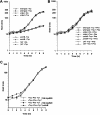Physiological effects of anti-TRAP protein activity and tRNA(Trp) charging on trp operon expression in Bacillus subtilis
- PMID: 18178730
- PMCID: PMC2258860
- DOI: 10.1128/JB.01820-07
Physiological effects of anti-TRAP protein activity and tRNA(Trp) charging on trp operon expression in Bacillus subtilis
Abstract
The Bacillus subtilis anti-TRAP protein regulates the ability of the tryptophan-activated TRAP protein to bind to trp operon leader RNA and promote transcription termination. AT synthesis is regulated both transcriptionally and translationally by uncharged tRNA(Trp). In this study, we examined the roles of AT synthesis and tRNA(Trp) charging in mediating physiological responses to tryptophan starvation. Adding excess phenylalanine to wild-type cultures reduced the charged tRNA(Trp) level from 80% to 40%; the charged level decreased further, to 25%, in an AT-deficient mutant. Adding tryptophan with phenylalanine increased the charged tRNA(Trp) level, implying that phenylalanine, when added alone, reduces the availability of tryptophan for tRNA(Trp) charging. Changes in the charged tRNA(Trp) level observed during growth with added phenylalanine were associated with increased transcription of the genes of tryptophan metabolism. Nutritional shift experiments, from a medium containing tryptophan to a medium with phenylalanine and tyrosine, showed that wild-type cultures gradually reduced their charged tRNA(Trp) level. When this shift was performed with an AT-deficient mutant, the charged tRNA(Trp) level decreased even further. Growth rates for wild-type and mutant strains deficient in AT or TRAP or that overproduce AT were compared in various media. A lack of TRAP or overproduction of AT resulted in phenylalanine being required for growth. These findings reveal the importance of AT in maintaining a balance between the synthesis of tryptophan versus the synthesis of phenylalanine, with the level of charged tRNA(Trp) acting as the crucial signal regulating AT production.
Figures




Similar articles
-
Positions of Trp codons in the leader peptide-coding region of the at operon influence anti-trap synthesis and trp operon expression in Bacillus licheniformis.J Bacteriol. 2010 Mar;192(6):1518-26. doi: 10.1128/JB.01420-09. Epub 2010 Jan 8. J Bacteriol. 2010. PMID: 20061467 Free PMC article.
-
Complexity in regulation of tryptophan biosynthesis in Bacillus subtilis.Annu Rev Genet. 2005;39:47-68. doi: 10.1146/annurev.genet.39.073003.093745. Annu Rev Genet. 2005. PMID: 16285852 Review.
-
Tandem transcription and translation regulatory sensing of uncharged tryptophan tRNA.Science. 2003 Jul 11;301(5630):211-3. doi: 10.1126/science.1084902. Science. 2003. PMID: 12855807
-
Effects of tryptophan starvation on levels of the trp RNA-binding attenuation protein (TRAP) and anti-TRAP regulatory protein and their influence on trp operon expression in Bacillus subtilis.J Bacteriol. 2005 Mar;187(6):1884-91. doi: 10.1128/JB.187.6.1884-1891.2005. J Bacteriol. 2005. PMID: 15743934 Free PMC article.
-
The different roles of tryptophan transfer RNA in regulating trp operon expression in E. coli versus B. subtilis.Trends Genet. 2004 Aug;20(8):367-74. doi: 10.1016/j.tig.2004.06.007. Trends Genet. 2004. PMID: 15262409 Review.
Cited by
-
Gene regulation by substoichiometric heterocomplex formation of undecameric TRAP and trimeric anti-TRAP.Proc Natl Acad Sci U S A. 2014 Mar 4;111(9):3442-7. doi: 10.1073/pnas.1315281111. Epub 2014 Feb 18. Proc Natl Acad Sci U S A. 2014. PMID: 24550461 Free PMC article.
-
An overview of RNAs with regulatory functions in gram-positive bacteria.Cell Mol Life Sci. 2010 Jan;67(2):217-37. doi: 10.1007/s00018-009-0162-8. Epub 2009 Oct 27. Cell Mol Life Sci. 2010. PMID: 19859665 Free PMC article. Review.
-
Mechanism for pH-dependent gene regulation by amino-terminus-mediated homooligomerization of Bacillus subtilis anti-trp RNA-binding attenuation protein.Proc Natl Acad Sci U S A. 2010 Aug 31;107(35):15385-90. doi: 10.1073/pnas.1004981107. Epub 2010 Aug 16. Proc Natl Acad Sci U S A. 2010. PMID: 20713740 Free PMC article.
-
Positions of Trp codons in the leader peptide-coding region of the at operon influence anti-trap synthesis and trp operon expression in Bacillus licheniformis.J Bacteriol. 2010 Mar;192(6):1518-26. doi: 10.1128/JB.01420-09. Epub 2010 Jan 8. J Bacteriol. 2010. PMID: 20061467 Free PMC article.
References
-
- Antson, A. A., E. J. Dodson, G. Dodson, R. B. Greaves, X. Chen, and P. Gollnick. 1999. Structure of the trp RNA-binding attenuation protein, TRAP, bound to RNA. Nature 401235-242. - PubMed
-
- Babitzke, P., J. T. Stults, S. J. Shire, and C. Yanofsky. 1994. TRAP, the trp RNA-binding attenuation protein of Bacillus subtilis, is a multisubunit complex that appears to recognize G/UAG repeats in the trpEDCFBA and trpG transcripts. J. Biol. Chem. 26916597-16604. - PubMed
-
- Babitzke, P., and C. Yanofsky. 1995. Structural features of L-tryptophan required for activation of TRAP, the trp RNA-binding attenuation protein of Bacillus subtilis. J. Biol. Chem. 27012452-12456. - PubMed
Publication types
MeSH terms
Substances
LinkOut - more resources
Full Text Sources

